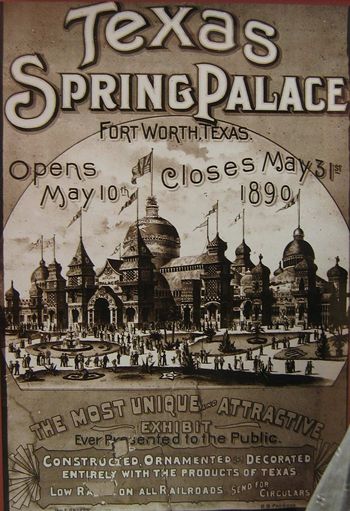|
|
What
happened at Fort Worth's
lavish Spring Palace that spring night in the so-called Gay Nineties
is a little-known chapter in Texas history, a "what if" of huge proportion.
It could have been one of Texas's -- and the nation's -- worst disasters.
As it is, Galveston
holds that unfortunate distinction with the 1900
hurricane that killed 6,000-plus people. However, as many as 7,000
people had been inside the Spring Palace when a flash fire broke out
and quickly consumed the building.
Less than two years before, in the latter part of 1888, R.A. Cameron
came up with an idea to boost Fort
Worth. The local agent for the Fort Worth and Denver Railroad,
he suggested construction of a magnificent exhibition building similar
to the Corn Palace then located in Sioux City, Iowa. Cow Town's movers
and shakers thought it a great idea, and quickly raised $50,000 toward
construction of a facility to be known as the Spring Palace.
The large, architecturally extravagant structure would go up at the
foot of Main Street adjacent to the tracks of the Texas and Pacific
Railroad. Plans called for a cross-shaped wooden building of 60,000
square feet, an area equivalent to 240 average-sized suburban houses.
A two-story main building would be decorated with numerous towers,
spires and domes in a mixture of Oriental, Malaysian and Moorish styles.
In so enthusiastically endorsing construction of such a grand building,
Fort Worth civic leaders
may have been dealing with a bad case of Capitol envy. Down in Austin,
a massive new
state house built of red Texas granite had just been opened to
the public. While the Spring Palace would not compare with the Capitol
in size, when completed the Palace's largest dome would look somewhat
Capitol-ish. |
 |
|
Using 500,000
board feet of East Texas
pine and 175 kegs of nails, a workforce of 100 men raised the building
in only 30 days. When the carpenters left, club women spent another
six weeks decorating the inside of the structure in a Texas agricultural
motif. Since the purpose of the Palace was to showcase the state's
various agricultural products, the women covered the walls with
corn stalks, cotton, fruits, nuts, vegetables and wheat. Everything
came from Texas.
Gov. Sul Ross came up from Austin
for the dedication, a no-expenses-spared celebration of speechifying,
music, food and drink staged in May 1889. Described by one Fort
Worth newspaper as "the most beautiful structure ever erected
upon the earth," the building and all the many things it held --
from commodity samples to Texas-quarried stone to industrial products
to historical artifacts -- drew large crowds. In addition to its
primary purpose of being a place where visitors and potential investors
and immigrants could see all that Texas had to offer, the Spring
Palace became a popular venue for concerts, theatrical productions
and cotillions.
By
1890, just as the Fort
Worth business community had hoped for, the Spring Palace had
helped put Cow Town on the map. That spring's three-week exhibition
and performance season would be capped by a grand ball on the evening
of May 30.
Some 7,000 people jammed the Spring Palace for the event. By all
accounts, it was a memorable occasion, thoroughly enjoyed by everyone
who attended. Finally, around 10 p.m., the band played its last
number and those in attendance began moving toward the building's
16 exits. That's when the fire started.
Striking as it was, the Spring Palace amounted to a giant bonfire
awaiting only a source of ignition. Licking through all the dried
vegetation like so much kindling, flames soon engulfed the building.
Horse-drawn fire wagons with steam-powered pumps raced to the scene,
but firemen could do nothing to stop the conflagration.
"I was with a group on the second floor and the blaze broke out
about ten feet from where I was sitting," Mrs. R.L. Taylor later
recalled. "As I ran down the stairway, I caught the heel of my shoe
which broke off and I fell. Some man picked me up and carried me
downstairs and by the time I could run across the street, the back
of my dress was scorched and ruined."
The building filled with flames, smokes and screams as the cream
of Fort Worth and
North Texas
society desperately scrambled to get outside. Many of those trapped
on the second floor had to jump from the windows.
One of those who had been on hand for the gala was 41-year-old Alfred
S. Hayne, an English-born civil engineer . He could have escaped,
but he stayed on the second floor and began helping women and children
out of the growing inferno by lowering them to the ground with a
rope he somehow appropriated.
"Everyone was running and screaming...," Miss Ida Lee Wyse remembered.
"We managed to get out just as the building fell in."
Hayne literally tossed one last women out of the window and then
leaped out himself. Spectators caught the falling woman, but not
Hayne, who hit the ground hard.
The impact broke a leg and severely injured his back, but that was
only a secondary problem. As one account put it, "He was burned
on every part of his body." Despite his pleas of "For God's sake,
boys, kill me!" he was taken to a hospital. Two tortuous hours later,
he died.
Amazingly, of all the humanity in the Spring Palace that night,
Hayne was the only fatality. The grateful people of Fort
Worth placed a monument to Hayne's heroism that stands on Lancaster
Street between Main and Houston streets, but the Spring Palace is
largely forgotten today.
|
|
|
